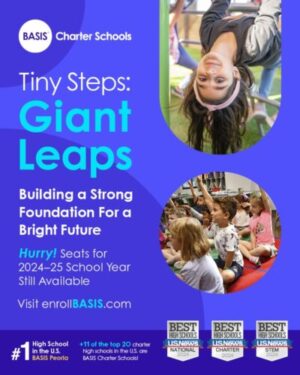By Christine Thompson, President and CEO, Expect More Arizona
Special needs education funding is impacting all students. ‘We’re all working toward working ourselves out of a job,’ was something Kimberly Peaslee, a special education professional, regularly heard from one of her professors. “He always reminded us that the earlier we can provide high quality interventions, the less we’d be needed further down the road,” said Peaslee. “Our aim was to help every student with special needs to be independent. We want to arm them with skills to be productive members of society.”
In Arizona today, there are an estimated 112,000 students who fall into special education categories. That’s about 11 percent of the student population. Yet, many people don’t understand what special education really means, how it’s funded, or the extent of impact special education has, even on students who aren’t part of it.
What is special education?
Special education encompasses a wide variety of students. It may be a youth diagnosed with mild dyslexia, those who have visual or hearing impairments, learning delays, autism, or many others. There are 13 categories, in all, that are set forth by federal law.
The Individuals with Disabilities Education Act (IDEA) dictates how schools work with these students and the level of services that should be provided. Some will need to see a specialist a few times per week, while others require a full-time nurse or aide.
Each child who is determined to be eligible for special education services will get an Individualized Education Program, or IEP as they’re commonly known, to guide and monitor their progress. Written with input from school professionals and caregivers, an IEP sets forth where the student is today, what goals are appropriate and what services they’ll need to meet those goals.
“There are more special education students in general education classrooms than in special education classes,” noted Adam Leckie, assistant superintendent at Florence Unified School District. “It’s invisible disabilities, such as dyslexia, that are far more common than visible challenges, such as spina bifida or orthopedic impairments.”
If I don’t have children with special needs, how does it still impact me?
“In a state where the entire system is beset with chronic teacher shortages, special education is even more challenged,” said Alissa Krantz, director of special education at Glendale Union High School District. “Finding and retaining qualified teachers is hard enough if you’re looking for math help – it’s even harder for special education. And it’s not just teachers we need. Schools also have to employ speech pathologists, occupational therapists, psychologists, and other professionals who can earn far more outside of school walls.”
Districts like Florence Unified have had job openings for these types of professionals that haven’t been filled for over a year. They’re forced to rely on existing staff in the meantime, which isn’t ideal for either staff or students.
While federal law dictates what services could be provided to special education students, these services aren’t funded adequately. Districts all over the state cope with this disparity by using funds from the general education population.
“Special education students represent about 14 percent of our student population in Florence Unified,” said Leckie. “But they account for 24 percent of our yearly spending. This isn’t an uncommon disparity in many districts around the state.”
At Glendale Union, the funding gap is similar. It’s estimated that special education students comprise 12 percent of the student population, but account for 20 percent of the budget.
Funding is a challenge at every turn, as is the downturn in students enrolling in teacher preparation programs. While changing requirements for certifications has meant more teachers in general education classrooms, the unique skillsets required of special education educators is harder to come by. They’re prepared to work with either high- or low-incident disabilities, with specialized strategies and skills.
“We can’t expect to alter outcomes without well-trained and well-supported teachers,” said Leckie. “Districts just can’t pick up the slack that a teacher can.”
How have schools adapted to teaching special education students during closures?
Educators at every level want to ensure that students reach their potential; that they are able to get well-rounded, enriching educational experiences. During the unprecedented COVID-19 closures, educators worked hard to adjust to distance learning techniques. This was especially challenging for special education, given the potential for language barriers, need for physical assistance or importance of eye contact.
“Many educators work in partnership with families of special needs students,” Krantz, added. “Schools continue to provide as many services as they safely could, based on student needs. Of course, educators are very much looking forward to seeing their students again. But the relationships developed between schools and families has been invaluable.”
Working together has created stronger bonds between families and educators. Students continue to receive the help they need, despite novel hardships presented by unprecedented school closures.
Prior to COVID-10 closures, the state legislature had been considering increasing funding for special education youth, but that has been derailed and may not be a priority moving forward. In the meantime, all students suffer from the shortage of funding for services that are mandated by federal law.
In the coming school year, the need for more funding will be more prominent than ever. Lost instruction time, coupled with the stress of closures, will mean students need more help than ever. Every student in our state deserves access to a high-quality education, regardless of their zip code, or special needs.
Expect More Arizona is a nonprofit, nonpartisan advocacy organization bringing communities together to create positive change in education at all levels. Learn more at ExpectMoreArizona.org.





